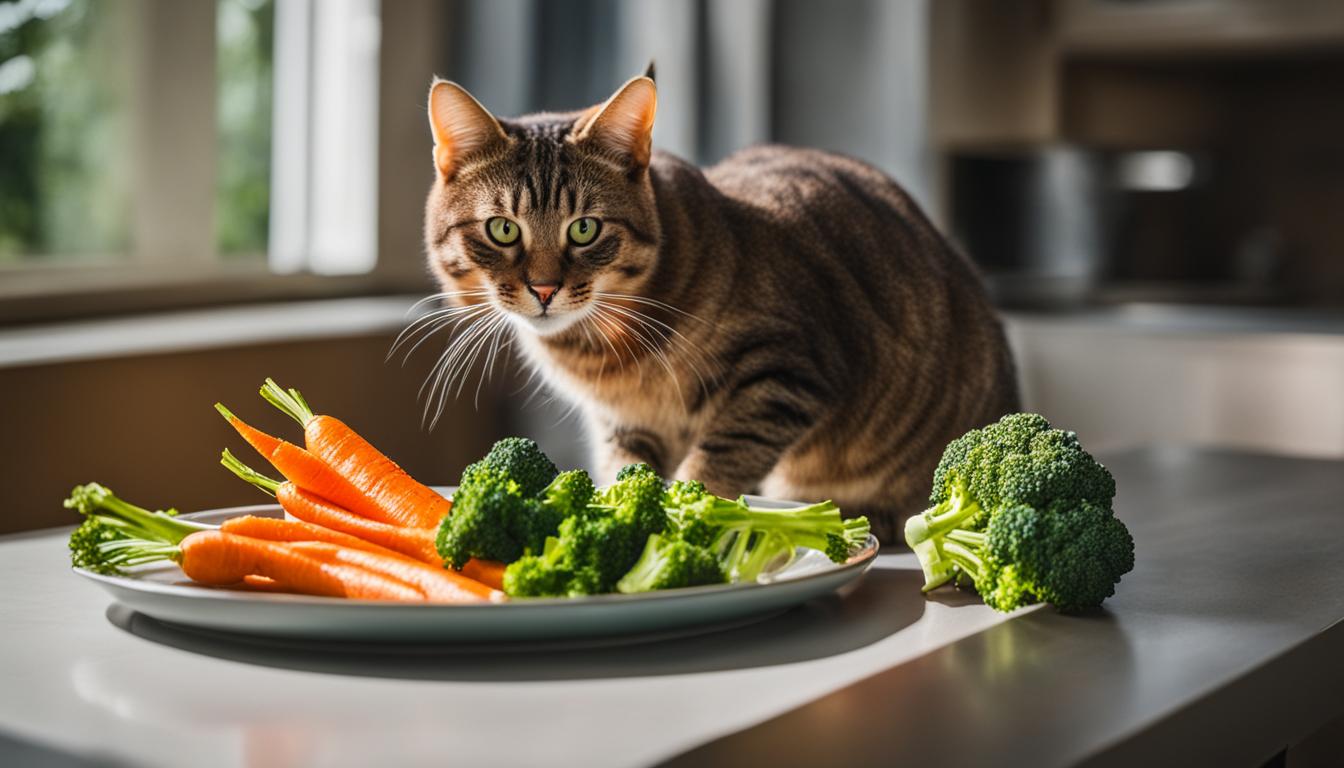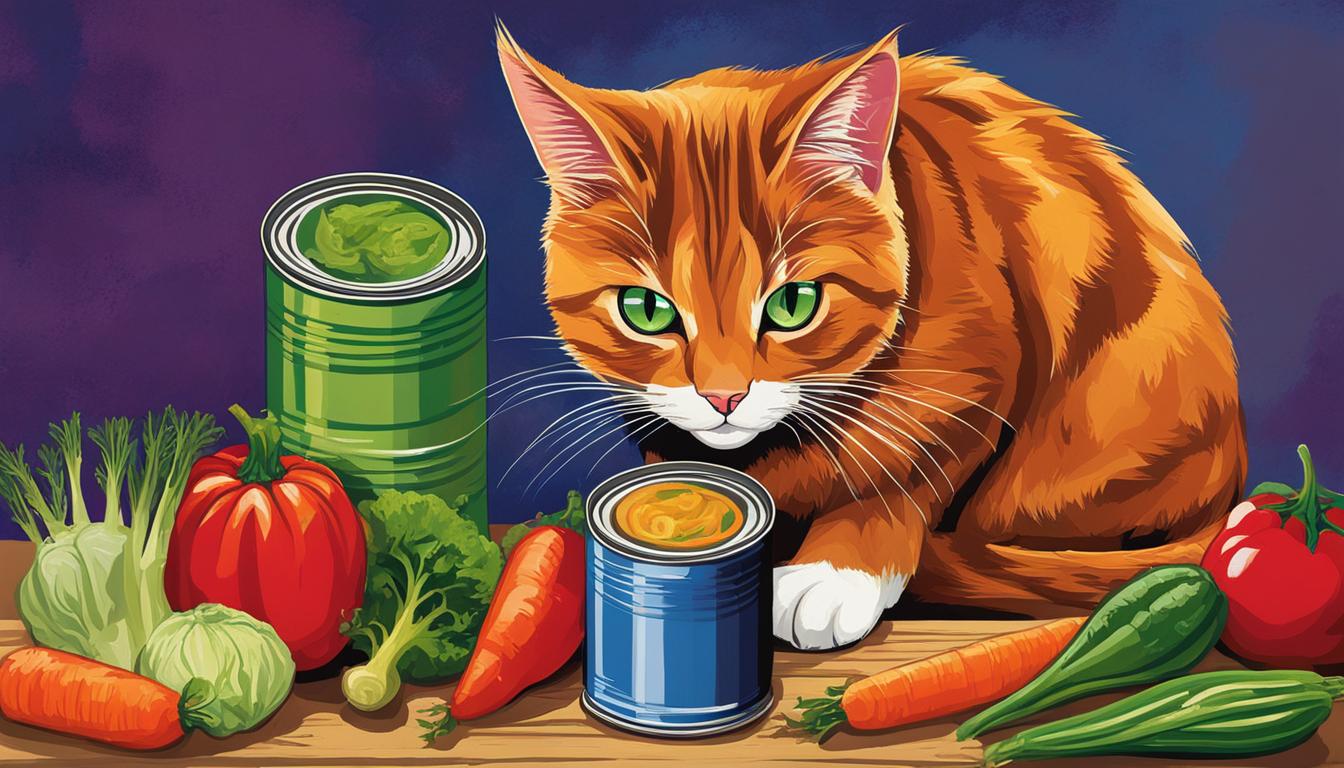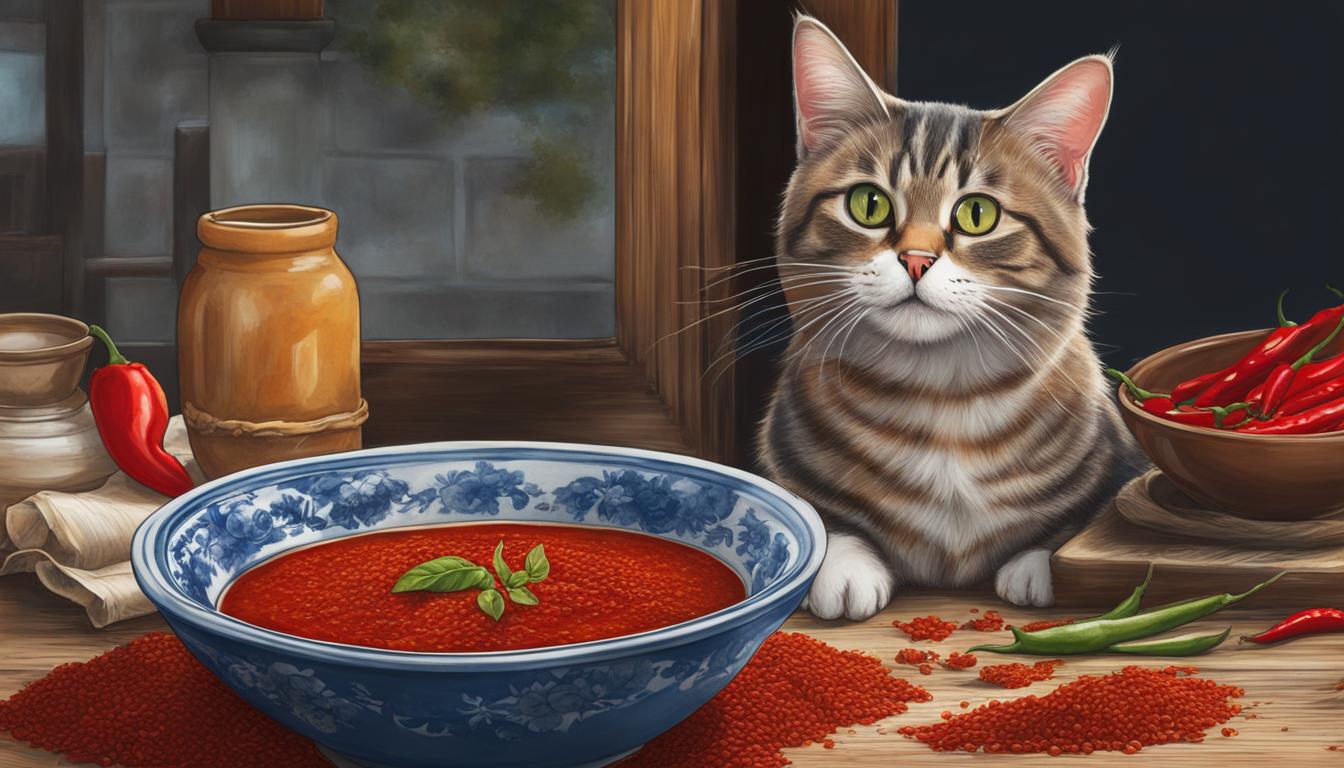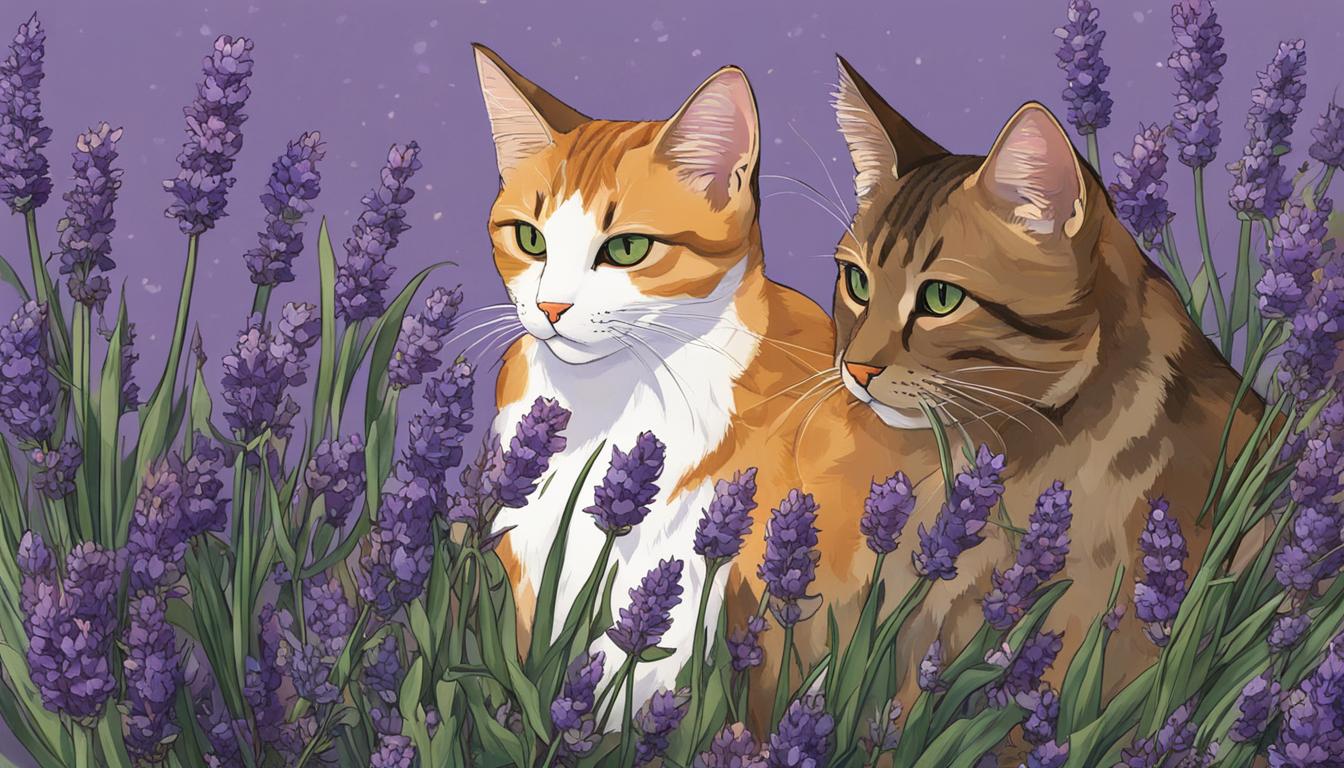As a curious cat owner, you may have wondered if your feline friend can munch on some veggies. After all, we humans love our carrots and broccoli, but can cats enjoy them too? Let’s dig into the fascinating world of vegetable nutrition for cats and find out!
Cats have unique dietary needs as obligate carnivores, with meat being the primary component of their diet. However, incorporating small amounts of vegetables into their meals can offer some health benefits. Carrots and broccoli, when given in moderation, can provide essential vitamins, minerals, and fiber for your cat’s well-being.
But hold on, before you rush to the kitchen with a bowl of veggies, it’s crucial to prepare and serve them properly. Ensuring that carrots and broccoli are easily digestible for cats is key to their enjoyment and nutritional absorption.
Key Takeaways:
- Cats can eat carrots and broccoli, but in moderation.
- Carrots offer beta carotene, vitamins, minerals, and fiber for feline health.
- Broccoli is safe for cats and provides various nutritional benefits.
- Steam, blanch, or boil broccoli for improved digestibility.
- Homemade vegetable treats can be a healthy addition to your cat’s diet.
Nutritional Benefits of Carrots for Cats
Carrots are not just a popular snack for humans, but they can also provide several nutritional benefits for cats. These crunchy vegetables are rich in beta carotene, which is essential for feline health. Beta carotene is converted into vitamin A in the body, which plays a vital role in maintaining healthy vision, immune function, and cell growth.
In addition to beta carotene, carrots also contain other vitamins and minerals that support proper bodily functions in cats. These include vitamin K, which aids in blood clotting, and potassium, which is important for heart and muscle function. Carrots are also a good source of fiber, which can help improve digestion, especially for cats that are prone to constipation.
When serving carrots to your cat, it is best to cook them to make them easier to digest. Raw carrots can be difficult for cats to chew and may pose a choking hazard. Steamed or boiled carrots are a safe and nutritious option for your feline friend. You can chop them into small, bite-sized pieces to make them more manageable for your cat to eat.
| Nutrient | Amount per 1 cup of chopped carrots |
|---|---|
| Beta Carotene | 16,706 micrograms |
| Vitamin K | 16.9 micrograms |
| Potassium | 390 milligrams |
| Fiber | 3.6 grams |
“Carrots are a nutritious addition to a cat’s diet, providing essential vitamins, minerals, and fiber. Just remember to cook them to ensure they are easily digestible for your feline friend.”
Remember that while carrots can be a healthy treat for cats, they should only be given in moderation as part of a balanced diet. Too many carrots can cause an imbalance in your cat’s dietary needs, so it’s important to consult with your veterinarian to determine the appropriate portion size for your cat.
Incorporating carrots into your cat’s diet can provide them with valuable vitamins, minerals, and fiber. However, it’s essential to consider your cat’s individual dietary needs and consult with your veterinarian before making any significant changes to their diet.
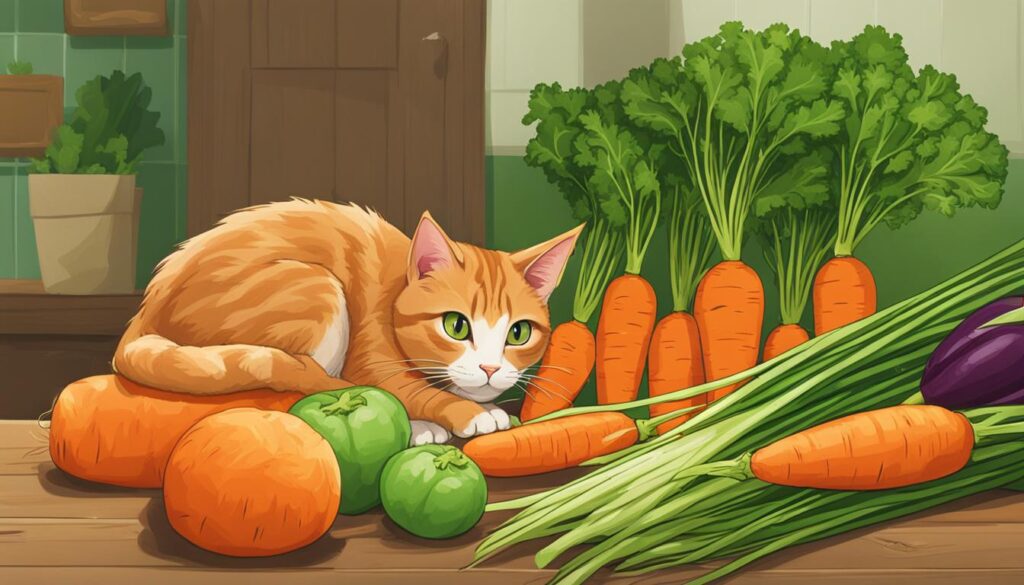
How to Prepare Broccoli for Cats
Broccoli is a safe and nutritious vegetable that you can incorporate into your cat’s diet. However, it is important to prepare broccoli properly to ensure it is easily digestible for cats. Here are some steps on how to prepare broccoli for your feline friend:
Steaming
Steaming is one of the best cooking methods for broccoli as it helps retain the vegetable’s nutrients while making it softer and easier to chew for cats. To steam broccoli, simply place it in a steamer basket over boiling water and steam for about 5-7 minutes or until it becomes tender. Be sure to let the broccoli cool before serving it to your cat.
Blanching
Blanching is another great way to prepare broccoli for cats. To blanch broccoli, boil it in water for about 2-3 minutes, then immediately transfer it to a bowl of ice water to stop the cooking process. Blanching helps make the broccoli more palatable and easier for cats to digest.
Boiling
If you prefer a simpler cooking method, you can also boil broccoli for your cat. To do this, bring a pot of water to a boil and add the broccoli. Boil for about 4-5 minutes or until the broccoli becomes tender. Drain the broccoli and allow it to cool before serving it to your cat.
Remember to always serve broccoli to your cat in small, bite-sized pieces to prevent choking. Start with a small amount of broccoli and monitor your cat’s reaction before gradually increasing the serving size. While broccoli is safe for cats, it’s important to note that not all cats may enjoy the taste or texture of this vegetable. If your cat refuses to eat broccoli, don’t force it and try offering other cat-friendly vegetables instead. Variety is key when it comes to providing a well-balanced diet for your furry friend.
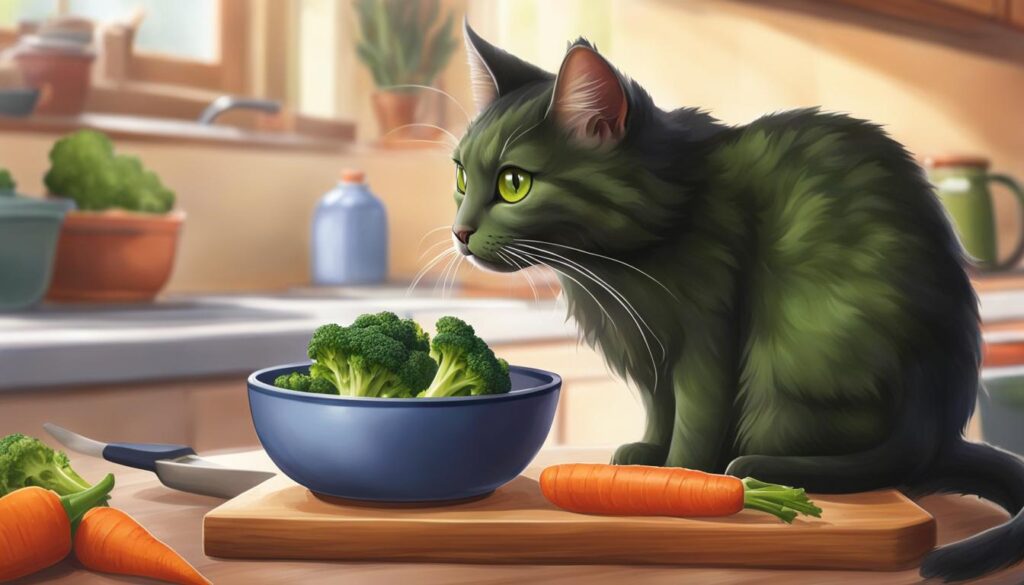
Homemade Vegetable Treats for Cats
If you’re looking to add some variety to your cat’s diet and incorporate more vegetables, homemade vegetable treats can be a great option. Not only can these treats provide additional nutrients and fiber, but they also give you the opportunity to bond with your feline friend through the preparation and sharing of delicious snacks.
Making Carrot Sticks
Carrots are a safe and healthy vegetable option for cats. They are packed with beneficial nutrients like beta carotene and vitamin A. To make carrot sticks for your cat, start by peeling and washing the carrots. Cut them into thin, finger-sized sticks and steam them until they are tender. Allow the carrot sticks to cool before serving them to your cat. Remember to always give treats in moderation, as too much of a good thing can upset your cat’s digestive system.
Broccoli Florets for a Crunch
Broccoli is another vegetable that can be enjoyed by cats. It contains vitamins, minerals, and fiber that contribute to overall well-being. To prepare broccoli florets as a treat, steam or blanch them until they are soft. Let them cool down before offering them to your furry companion. Cats enjoy the crunch of broccoli, and it can be a fun and healthy alternative to traditional treats.
Green Bean Slices for a Fresh Snack
Green beans are a low-calorie vegetable that can be given to cats as a tasty snack. They are rich in vitamins and minerals and can be served raw or lightly steamed. To make green bean slices, wash the beans and cut them into bite-sized pieces. If your cat prefers a softer texture, steam the green beans for a few minutes before cooling and serving. Green bean slices can be a refreshing and nutritious treat for your cat.
Remember to always introduce new foods gradually and monitor your cat’s reaction. Some cats may have individual preferences or allergies, so it’s important to consult with a veterinarian if you have any concerns. Additionally, be cautious with seasonings or additives as they can be harmful to cats. Stick to plain and unseasoned vegetables to ensure your homemade treats are safe and healthy for your feline friend.
| Treat | Preparation Method | Serving Suggestion |
|---|---|---|
| Carrot sticks | Peel, wash, and steam | Cool before serving |
| Broccoli florets | Steam or blanch | Let cool before offering |
| Green bean slices | Wash and slice, steam if desired | Serve raw or cooled |
Safe Cooking Methods for Cat Vegetables
When it comes to cooking vegetables for your feline friend, it’s important to use safe methods that preserve their nutritional value and make them easily digestible. Steaming, blanching, and boiling are recommended cooking techniques that soften the vegetables and enhance their palatability for cats. By following these safe cooking methods, you can ensure that your cat receives all the benefits of vegetables without any potential harm.
Steaming
Steaming is a gentle and effective way to cook vegetables for cats. It helps retain the nutrients while softening the texture for easy consumption. Simply place the vegetables in a steamer basket over boiling water and cook until tender. Once steamed, allow the vegetables to cool before serving them to your cat. Steamed vegetables are a great addition to your cat’s diet, providing essential vitamins, minerals, and fiber.
Blanching
Blanching is another safe cooking method for cat vegetables. It involves briefly immersing the vegetables in boiling water, then transferring them to an ice bath to stop the cooking process. Blanching helps to remove any bitterness and toughen the vegetables’ cell walls, making them easier to digest. After blanching, be sure to drain and cool the vegetables before offering them to your cat.
Boiling
Boiling is a straightforward cooking method that can soften vegetables for cats. Simply add the vegetables to a pot of boiling water and cook until they are tender. Boiling vegetables can help break down the fibers, making them easier to digest. However, be cautious not to overcook them as this can result in the loss of some nutrients. Once boiled, cool the vegetables and serve them to your cat in small, manageable portions.
Remember to avoid using seasonings, salt, or oil when preparing vegetables for your cat. These additives can be harmful to their health. By following these safe cooking methods, you can ensure that your cat enjoys the nutritional benefits of vegetables in a way that is safe and delicious.
Raw vs Cooked Vegetables for Cats
When it comes to feeding vegetables to cats, a common question that arises is whether it’s better to serve them raw or cooked. While some cats may tolerate small amounts of raw vegetables, it is generally safer to opt for cooked vegetables. Cooking vegetables helps break down the fiber and plant cells, making it easier for cats to digest and absorb the nutrients.
Why should you cook vegetables for your feline friend?
One reason is that raw vegetables can be difficult for cats to chew and may pose a choking hazard. Additionally, cooking vegetables improves their digestibility, which is especially important for cats with sensitive stomachs. By cooking the vegetables, you can soften them and make them more palatable for your feline friend.
“While some cats may tolerate small amounts of raw vegetables, it is generally safer to opt for cooked vegetables.”
Another benefit of cooking vegetables for cats is that it helps unlock their nutritional potential. Cooking can help release and make more readily available the vitamins, minerals, and other beneficial compounds present in vegetables. This ensures that your cat is able to fully benefit from the nutritional value of the vegetables you are offering.
Furthermore, cooking vegetables allows you to control the preparation and seasoning, ensuring that no harmful additives or seasonings are included. This is important as certain seasonings and additives can be toxic to cats. By cooking the vegetables yourself, you have full control over their safety and nutritional content.
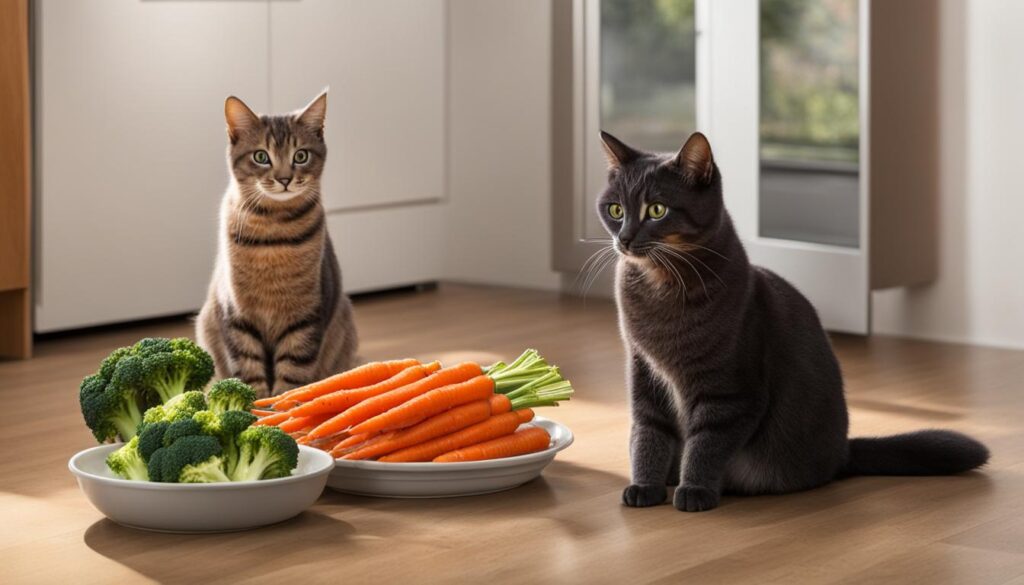
Vegetable Allergies in Cats
Just like humans, cats can develop allergies to certain vegetables. These allergies can cause various symptoms, including itching, redness, swelling, and digestive upset. If you notice any of these signs after your cat consumes a specific vegetable, it’s important to consider the possibility of a vegetable allergy.
When it comes to vegetable allergies in cats, it’s crucial to consult with a veterinarian for an accurate diagnosis. They can help determine the specific allergen and guide you in developing a suitable dietary plan for your furry friend. By identifying the problematic vegetable and eliminating it from your cat’s diet, you can help relieve their discomfort and prevent future allergic reactions.
“If you notice any signs of an allergic reaction after your cat consumes a certain vegetable, it’s important to seek veterinary advice. They will be able to guide you in managing your cat’s diet and finding suitable alternatives.”
Common Vegetable Allergens
While any vegetable can potentially cause an allergic reaction in cats, there are a few common allergens to be aware of. These include:
- Tomatoes: Some cats may be allergic to the Solanum alkaloids present in tomatoes, which can cause gastrointestinal distress and allergic reactions.
- Peas: Pea allergies are not uncommon in cats, with symptoms ranging from digestive upset to skin irritations.
- Squash: Certain compounds found in squash, such as cucurbitacins, can trigger allergic reactions in cats, leading to vomiting and diarrhea.
- Corn: Cats can also develop allergies to corn, which may result in skin irritations, itching, and gastrointestinal issues.
It’s important to note that this list is not exhaustive, and any vegetable can potentially cause an allergic reaction in cats. If you suspect your cat has an allergy to a specific vegetable, it’s best to consult with your veterinarian for a proper diagnosis and guidance on managing their diet.
| Allergenic Vegetables | Potential Symptoms |
|---|---|
| Tomatoes | Gastrointestinal distress, allergic reactions |
| Peas | Digestive upset, skin irritations |
| Squash | Vomiting, diarrhea |
| Corn | Skin irritations, itching, gastrointestinal issues |
Remember, always monitor your cat’s reaction to new vegetables and consult with your veterinarian if you suspect an allergy. With proper care and guidance, you can ensure your cat’s diet remains safe, nutritious, and free from allergic reactions.
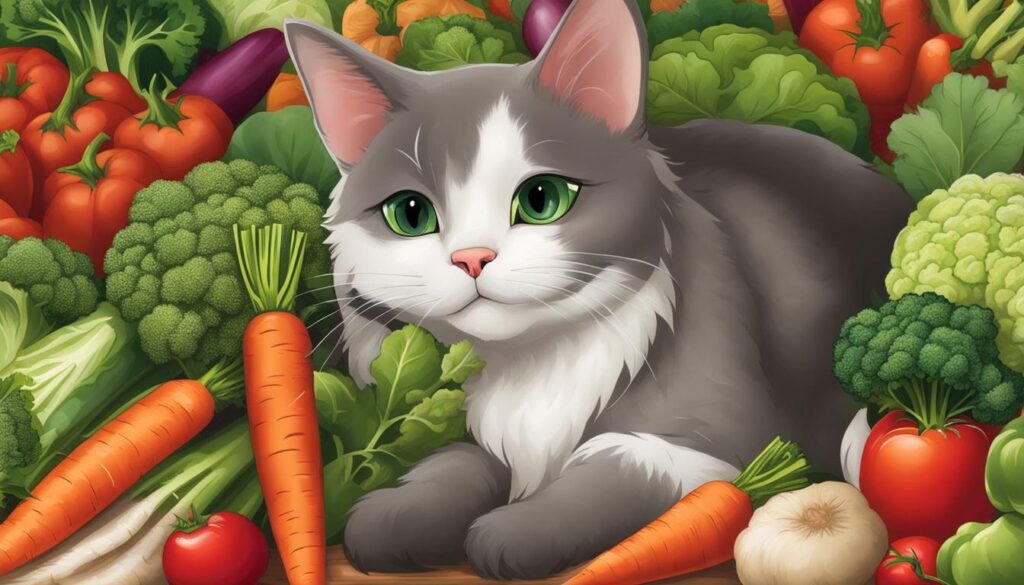
Conclusion
So, can cats really enjoy a mixed vegetable diet? The answer is yes, but in moderation and with proper preparation. Carrots and broccoli can offer valuable nutritional benefits to cats, including vitamins, minerals, and fiber. However, it’s essential to remember that cats are obligate carnivores, and their main diet should consist of meat.
When incorporating vegetables into your cat’s diet, it’s crucial to cook them properly to enhance digestibility. Steaming, blanching, and boiling are safe cooking methods that soften the vegetables and make them more palatable for our feline friends. Avoid using any seasonings, salt, or oil, as these can be harmful to their health.
Homemade vegetable treats can also be a delightful addition to your cat’s diet. You can offer them carrot sticks, broccoli florets, or slices of green beans. Just remember to cook the vegetables thoroughly and refrain from using any additives or seasonings. These treats should only be given in moderation as part of a balanced diet.
If your cat has any allergies or sensitivities, it’s always best to consult with a veterinarian before introducing vegetables into their diet. They can help determine the best approach and ensure your cat’s nutritional needs are met. Remember, a mixed vegetable diet can be a healthy complement to your cat’s main meat-based diet, providing them with a variety of nutrients to support their overall well-being.
FAQ
Can cats eat carrots or broccoli?
Yes, cats can eat carrots and broccoli in moderation as part of a balanced diet.
What are the nutritional benefits of carrots for cats?
Carrots are rich in beta carotene, vitamins, minerals, and fiber, which support feline health and aid in digestion.
How should I prepare broccoli for cats?
Broccoli should be steamed, blanched, or boiled to improve digestibility for cats.
Can I make homemade vegetable treats for my cat?
Yes, you can make homemade vegetable treats such as carrot sticks, broccoli florets, and green bean slices for your cat.
What are the safe cooking methods for cat vegetables?
Steaming, blanching, and boiling are recommended cooking methods to soften vegetables for cats.
Should I feed cats raw or cooked vegetables?
It is generally safer to feed cats cooked vegetables as they are easier to digest and pose less of a choking hazard.
Can cats have vegetable allergies?
Yes, cats can develop allergies to certain vegetables, and common symptoms include itching, redness, swelling, and digestive upset.
Can I mix vegetables in my cat’s diet?
Yes, you can include vegetables in your cat’s diet, but it’s important to do so in moderation and monitor for any allergies or sensitivities.

